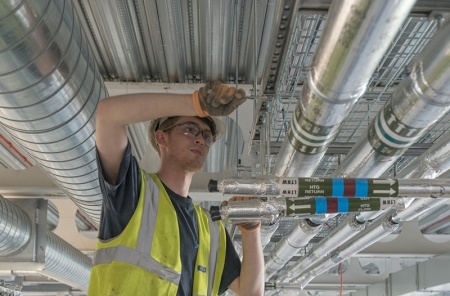
Fleet Electrification: Lessons from Hinkley Point C
With Britain now well on its journey toward a net zero future, many organisation's will have begun assessing the feasibility for fleet electrification and the steps involved in transitioning their vehicle stock to electric vehicles (EV's). In this blog post, Faizan Ahmad, Integrated Solutions Manager at EDF, shares some of the experiences and lessons learnt when upgrading the fleet of buses in operation at Hinkley Point C.
Hinkley Point C in Somerset will be the UK’s first nuclear power plant in a generation and is one of the largest construction sites in Europe. While the site itself is a spectacle to behold and is already associated with a string of superlatives (world’s largest crane, Britain’s biggest concrete pour, power for 6M homes), a key enabling factor which is often overlooked is the immense logistics feat of getting 4000+ workers to and from the site every day.
Whilst temporarily affected by Covid-19, this complex feat is presently accomplished by a fleet of buses operated by Somerset Passenger Solutions out of their main depot in Bridgwater. Last year, EDF launched a sustainability initiative to electrify the bus fleet and below are some of the key lessons learned from this ongoing project.
Headline numbers: 50,000 km/year and 5x
A full business case comparing the premium costs of electric vs. diesel buses would consider many factors including mileage, maintenance costs, lease rates, charging infrastructure, depreciation and of course electricity and fuel costs. However, other things being equal, we’ve found the electric bus value proposition starts to become compelling at the 50,000 km/year mileage threshold.
With regular cars, headline figures typically quoted are efficiencies of 5–7 km/kWh with battery packs of 50 kWh. The associated charging infrastructure would comprise of 3-22 kW AC chargers.
With electric buses, all key figures differ by about a factor of 5x. Efficiency goes down to 1-2 km/kWh and battery packs are 250+ kWh. Infrastructure also sees an upgrade to at least 60-120 kW chargers for most regular applications. Along with civils, electric bus charging infrastructure will most definitely require additional site electrical upgrades and intelligent controls to cope with higher charging loads.
Grid capacity looms large as a key issue for fleet electrification…
For small-scale EV infrastructure projects, available grid connection capacity is rarely a major issue and often just requires an after-the-fact notification to the local DNO. With the size and scale of electric buses however, it’s an entirely different matter.
Based on our experience, bus depots with an existing diesel fleet are typically sized with relatively small sub-50 kVA connections for basic lighting, space conditioning and ancillary loads. But even a small fleet of electric buses could require an additional 0.5-1 MVA of connection capacity to manage charging loads. Given widespread grid constraints, an initial application to the DNO for a connection upgrade of this size is likely, with an attributed cost for grid reinforcement and an implementation timeline potentially spanning months.
…but stationary storage can be an innovative solution
Enter stationary storage as a solution to the grid capacity challenge. If an appropriately sized stationary battery is installed at the depot, this can be charged from the grid by intelligently using up all excess site connection capacity available much of the day when buses are not charging.
Then, when buses come into the depot to charge, they can use the charged battery as the primary source of power, reducing the reliance on the grid. Such solutions, while elegant, require significant design and planning. Along with an evaluation of bus schedules, routes and battery capacity on return to depots, other factors to consider would be staggered charging schedules, load management as well as forecasts of fleet growth and change in use patterns. Based on our experience with the HPC project, a cross-functional team comprising data scientists, designers and technology specialists working in collaboration with end-users are best-placed to manage these challenges.
The numbers won’t necessarily work out in all cases, and a connection upgrade may still be required. However, the addition of the battery option could reduce the required connection upgrade and keep the project viable.
Change management is critical
The business case may be sound and the technology ready – but that’s only half the job done when getting an EV project off the ground, and we’ve found this especially true with electric buses. While range anxiety is a lesser concern given upfront design to ensure adequate battery capacity for routes, we’ve learned there are still a variety of on-ground realities and culture change factors to consider:
- Driver training: Drivers will need to be “brought on board” with the vision and retrained to drive a vehicle which may behave very differently. Though based on conversations with drivers with experience of the switchover, feedback is overwhelmingly positive.
- Passenger experience: Similarly, the passenger experience needs to be a key design consideration during bus procurement as well as operation. One surprising takeaway is that climate control for passengers within electric buses can often make up 30% of the total energy use.
- Maintenance: Maintenance bays and provider contracts will need to be repurposed, which can also pose special challenges for partial or trial rollouts.
- Planning: Very simple constraints such as lack of wall-space in the depots for charge-points can sometimes greatly limit the art of the possible.
Net Zero and the marriage between fleet and facilities
As electric vehicles become widespread, the line between energy/carbon management and fleet management has started to blur. At first glance, the extent of the project may seem to have been limited to new buses and associated charging infrastructure. But connection capacity constraints meant understanding present energy use and potential efficiency measures were important as a first step to releasing additional capacity for charging. Rooftop solar became a focus for the same reason. And then large-scale storage also became part of the picture to manage capacity constraints. As such, no one aspect can be looked at in isolation, and an integrated approach spanning EVs, efficiency, flexibility, storage and distributed generation is critical.
As transport is now the largest GHG emitting sector in the UK, fleet electrification projects are a key stepping stone to the UK’s 2050 Net Zero ambition. However, the positive air quality and public health benefits from EV projects are equally important as well. Perhaps this issue has come to the forefront during the present Covid-19 lockdown. The air is noticeably cleaner due to reduced road traffic and the resulting drop in PM 2.5 and NOx pollution. This silver lining provides a good preview of the positive environmental impacts of an EV-dominated transport system in the future. Given the potentially larger carbon and environmental impacts of greening mass transit vs. personal vehicles, passenger bus electrification projects such as the ongoing HPC initiative are all the more significant.
EDF provide a simple end-to-end solution that meets all of your electric vehicle needs. With expert advice and access to a range of products and services, the move to electric vehicles has never been easier. Is your organisation is currently exploring options for fleet electrification? Read more about our electric vehicle solutions for business.
Originally published on LinkedIn by Faizan Ahmad, Integrated Solutions Manager at EDF.
Post a comment
Related articles

EDF Energy Services acquires Imtech

Shedding light on Energy Performance Contracts (EnPCs)
